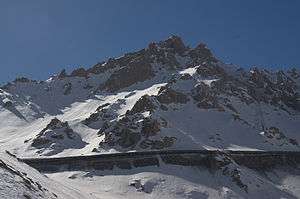Salang Tunnel fire

The Salang tunnel fire occurred on 3 November 1982 in Afghanistan's Salang tunnel during the Soviet occupation of Afghanistan. Details are uncertain, but the incident may have been the deadliest known road accident, and one of the deadliest fires of modern times.
Overview
The Salang tunnel, which opened the famous Salang Pass (or Kotal-e Salang) to motor traffic, was built by Soviet engineers in 1964 and eased traffic across the Hindu Kush mountain range that separates northern and southern Afghanistan.
Very few facts are known about the fire. All information available constitutes little more than hearsay, in part because the Soviet Army was not inclined to reveal massive losses during wartime. Most sources agree that it involved a Soviet Army convoy traveling southward through the tunnel.
Initial reports described fuel and ordnance explosions, and estimates of the death toll were as high as 2,700.[1] Shortly after the event, Western diplomats indicated that a collision with a fuel truck initiated the fire in the tunnel that led to the catastrophe resulting in the death of as many as 700 Soviet soldiers and 400 to 2,000 Afghan civilians.[2] People died either from fire or of asphyxiation.[2] The death toll was subsequently revised downwards many times.
According to Soviet Army records, on 3 November 1982 two military convoys (2211 and 2212) collided in the Salang tunnel causing a traffic jam. There were no fires or explosions. Sixty-four Soviet soldiers and 112 Afghan people were killed by carbon monoxide emitted by idling engines. US military analysts placed the casualty figure at 100 to 200 Soviet and Afghan soldiers.[2]
Another report from a traveler, who has been to the region, sounds very different from this official version: A fuel tanker in a military convoy exploded inside (the cause of the explosion remains somewhat in doubt with the Russians still claiming it was an accident and the Mujahideen still claiming it was a successful attack) the Salang Tunnel, unleashing an explosive chain reaction. Drivers of cars, trucks, and buses evidently continued to enter the tunnel after the explosion. Soviet troops, fearing that the explosion might have been a rebel attack, closed off both ends with tanks, trapping many inside. Some burned to death; others were killed by smoke and by carbon monoxide escaping from vehicles whose drivers kept their engines idling to stay warm in the freezing cold. As many as 700 Soviet troops and 2,000 Afghan soldiers and civilians may have died.[3]
Afghan insurgents said they did not have any role in the explosion in the tunnel.[2]
Prior to this, on 23 February 1980, a similar incident killed 16 Soviet soldiers in the Salang tunnel.[4]
See also
Notes
- ↑ AFGHANISTAN: Tunnel Tragedy - TIME
- 1 2 3 4 Associated Press (November 10, 1982). "Afghan Blast Toll is Put in Hundreds". New York Times. Retrieved February 8, 2017.
- ↑ Salang Pass, Salang Tunnel and The Last Battle | The Velvet Rocket
- ↑ In Russian Archived 2007-12-16 at the Wayback Machine.
External links and sources
- Summary from Frankfurt International School
- Casualty data from 2001 (of unknown accuracy)
- Tunnel length and altitude
- BBC News, Inside the Salang tunnel, 2002
- BBC News, Report on the state of the Salang tunnel, 2002
Coordinates: 35°19′19.91″N 69°1′36.72″E / 35.3221972°N 69.0268667°E